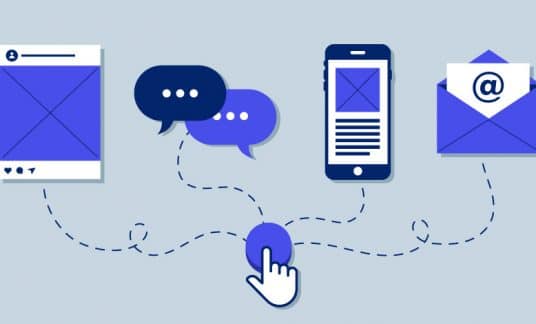Design isn’t about making things pretty.
OK, it is. But that isn’t all.
Good design is good business because it gives your customers exactly what they want. They want effortless and joyful experiences, clear communication and to know precisely what they’re getting. Good design solves all those problems for you.
It isn’t style over substance. You can’t slap a good-looking website together to cover up a flop of a product and expect that to build long-term business for you.
But when you combine your amazing product or service with great design, that’s when you’re unstoppable in the market.
Here’s exactly how design contributes directly to your bottom line.
Good Design Influences People
Companies with excellent design — a strong brand and appealing website — outperform the S&P Index by 219%, according to software company Adobe.
That isn’t merely a coincidence. There are no coincidences in business, right?
It’s because good design influences how your customers behave. A well-designed ecommerce website can result in hundreds of thousands of dollars in extra sales by implementing psychological buying factors, such as a sense of urgency.
By adding a sense of urgency, you can increase conversions by 332%, according to CXL, a provider of conversion rate optimization services.
This can be as simple as changing the wording of your “add to cart” buttons to be more direct, for example, from “Add to Basket” to “Buy Now.” Or it can be done by using a timer countdown to indicate how long you’ll “hold” the customer’s order before releasing it to others to buy, or how long a special deal is valid.

Take Action:
- Revise your call to actions (CTAs) to be direct. For example, change “Contact Us” to “Book a Call Now.”
- Display how much stock remains on physical items to buy, or list a countdown timer for special prices or offers for digital products, indicating the customer better act fast to secure their copy.
- Thoroughly test your website for 100% functionality, including during checkout or contacting you, and ease of use on all popular mobile devices.
Good Design Is Your Digital First Impression
According to several studies published by Stanford University, people determine the credibility of a business based largely on design factors, such as professionalism.

Studies published by Taylor & Francis show that visitors form an opinion about your website in 50 milliseconds. That’s how long you have to make a first impression.
This is especially important now during the coronavirus pandemic. In most places in the world, you cannot meet face to face with clients or prospects easily like before. You must rely solely on your digital presence to be seen as legitimate.
At a minimum, your website should be professionally designed by a reputable agency or contractor and be thoroughly tested to be functional across all device types, including mobile. Speed is also a major factor. About 47% of people expect a website to fully load in 2 seconds or less, according to a study by content delivery network services provider Akamai.
More than simply leaving, roughly 45% of people also report they’re less likely to buy from a company with a slow website, according to software company Unbounce.

A slow website is the digital equivalent of a weak, forgettable handshake. Don’t give customers a chance to write you off before they even know you with a slow or badly designed website.
Take Action:
- Review your website loading speed with a tool such as Pingdom and make any recommended changes to ensure your site loads as quickly as possible.
- Feel like your design is outdated? Reach out to a design agency for help.
- Add in subtle elements that bolster trust for your leads: contact information in your footer, business associations you belong to such as the Better Business Bureau, and links to established and regularly updated social media profiles.
Good Design Builds Stronger Customer Relationships
Design isn’t all visual. Good design in your business is more than how a website or software program looks. It impacts how it works, too, and the experience users have with it.
By making an experience easy or fun, you make it easy for a customer to come back, buy from you or recommend you to someone else.
Think about the last time you were frustrated by an unclear website process, slow loading times or glitchy apps. Would you recommend that company to a friend? Obviously not.
Not only would you be missing out on referrals with a bad design, but you also would be alienating your existing customers. According to a study by AppDynamics and the University of London, nearly 90% of customers said they had stopped using an app because of a bad user experience.
Part of the user experience also is using inclusive design. This ensures that people with disabilities can use your website and software. Poor design that does not take access needs into account will prevent customers with disabilities from buying from you and is a negative strike against your brand in many ways. While of course you should simply want to promote inclusion in your company, you may be thinking, “That’s not that many people.”
Actually, 1 in 4 Americans has some form of disability, according to the Centers for Disease Control and Prevention (CDC). You wouldn’t want a quarter of your potential customers unable to engage with you, right?

A few common design solutions for accessibility are to include a font size selector, use contrasting colors for background and text that make it easy for visually impaired people to read and to include alt text on all images for screen readers to understand.
Take Action:
- Ask someone in your company who isn’t familiar with your website to run through it, pretending to think like a customer. Get them to test out forms, make a purchase and other key transactions and report back to you on how easy and clear the process was (or wasn’t).
- Don’t have staff? You can hire website testers from sites such as UserTesting.
- Consider hiring a designer with accessibility experience to review your site or app to ensure it meets as many criteria as possible for disability inclusion and take action on any recommendations.
- As a bonus, adding alt text to your images is great for your search engine optimization (SEO), too.
Good Design Attracts Your Target Audience
How do you get qualified leads to your website?
You lure them in with targeted ads and organic content marketing that offers solutions for their problems, right? The same is true for the design of your website.
Branding is what attracts your target audience because it has been strategically designed to do just that. Good branding is what people remember about you.
Your logo, the colors you use, fonts, image and photography styles — all this isn’t random or there to simply look pretty. It’s there because your target audience responds to those colors and that imagery.
A good designer knows this and when given a brief on who you’re trying to reach, will deliver an aesthetically pleasing package that your target customers can’t help but be drawn to.
And as you know, hooking a live one is the first step in your funnel. You can’t get them on the hook without having a solid, clear and eye-catching design.
Take Action:
- First, get clear on who exactly your target audience is before designing anything.
- Effectively communicate your target audience to your design team and provide strategic direction on what motivates that audience and how your products tie into that. Be sure to share your customer personas and journey maps with them as well as your company goals.
- If your website, app and brand are already fully in place, consider asking your top customers to be part of a focus group to help you determine what drew them to you in the first place. With this knowledge, you can replicate that to find more perfect leads. You can offer these customers a discount or other special perks in exchange for their insight.
Good Design Builds a Strong Brand
As I mentioned above, a strong brand consists of an overall look and feel customers associate with you. But your brand is also how you come across. Are your communications fun and casual, like talking to a friend? Or are they formal and corporate?
There is no wrong answer when it comes to branding. It’s all about portraying your company in a way that is authentic to your values and resonates with your target audience.
All your digital assets, marketing materials and social media content should follow a consistent look and communication style to further cement your brand image and personality in your customers’ minds.
Good branding sells more. Consistent visual branding across all channels can impact your revenue by up to 33%, according to research by Lucidpress.
Take Action:
- Do I need to keep saying it? Never attempt a do-it-yourself approach to your brand. Always hire a professional designer.
- Think about how your target customers behave. Are they casual people or the boardroom corporate type? What’s their sense of humor like? Do they live in the suburbs or the city? Tea or coffee? You get the idea. Know your target and what they like, and that becomes your brand.
- Keep it consistent. Review your website, apps, social channels and any other materials to ensure the logo used is the same, brand colors are accurate and everything else forms a cohesive look. You should be able to look at any marketing creative and instantly know it’s part of your brand.
Good Design Is Good Business. Period.
Good design is good business and it isn’t optional anymore.
Consumers expect you to have a well-designed website, easy-to-read marketing materials and a professional and consistent brand. Anything less and you don’t appear to be a legitimate company by today’s digital standards.
You wouldn’t cheap out on critical elements of running your business, like computers or necessary personnel, so don’t cheap out when it comes to the design of your brand. Good design is one of the strongest business assets you can have, especially during a recession.
Don’t skimp out: Go for the full lobster. Get a website and brand professionally designed that’s going to propel your company forward by building trust, attracting qualified leads and positioning you as a market leader among your competition.











